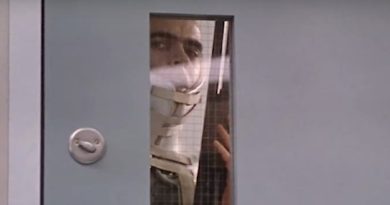Capsule Review: In a Violent Nature (2024) – A Subversive and Unique Take on the Slasher Genre
What if Friday the 13th is shot from the perspective of Jason Voorhees? That’s the high-concept premise behind In a Violent Nature, which marks Chris Nash’s solo feature debut after directing one of the 26 chapters (Z is for Zygote) in the horror anthology ABCs of Death 2.
Nash, who also scripted the movie, gets off to an intriguing but erratic first act as we follow a resurrected corpse named Johnny (Ry Barrett) rising from the ground. It all happens when a group of teenagers find a locket hanging from the ruins of a fire tower and pick it up. Johnny, all caked in dirt, begins looking for his missing locket. Here, Nash frames Johnny mostly from the back (think of it like you are playing a third-person video game) except for his face being obscured or blurred from certain angles. All we see is his hulking presence and footsteps navigating his way around the woods.
When Johnny finally preys on his first victim, the ensuing kill lacks the visceral flair that I would expect from a slasher movie. But Nash manages to improve considerably from the second act onwards, albeit with a few uneven changes of perspectives from the killer to the teenagers. Except for the part where the group sit around a campfire with one of them (Sam Roulston’s Ehren) talking about how Johnny died and the massacres that took place afterwards. The pacing may stall periodically during a few long, unhurried stretches of the camera focusing on Johnny walking in the woods. The deliberate approach is meant to mirror Johnny’s physically slow nature as an undead serial killer and it’s understandable. But to see it occur too often throughout the movie’s otherwise compact 94-minute length feels like it stretches longer than it should.
Nash gets creative in some of the brutal and gory kills, notably a stomach-churning moment revolving around Johnny dispatching one of the female victims with the chained hooks. The kind of unapologetically, in-your-face scene that doesn’t shy away from its graphic violence.
Interestingly, Nash eschews the traditional approach of adding a musical score, often an integral part of a slasher movie (prime examples like Halloween and Friday the 13th are renowned for their respectively unique themes) in favour of natural sound and ambient noise. There’s a palpable sense of dread and unease, proving that sometimes the use of music isn’t necessary to evoke one’s emotions and reactions. The formidable presence of the serial killer alone, coupled with the uncertainty and apprehension lurking in the otherwise serene forest (shot in locations in Ontario, Canada) is more than enough to give me the creeps.
The ending is what further sets the movie apart other than its conceptual killer’s perspective story angle. Let’s just say it’s rather an unconventional way Nash chose to end his movie. It may have been a polarising decision that can be a turn-off for (many) people — particularly, fans of the slasher genre — watching it. Personally, I like how Nash subverts the usual expectations, giving us a sly conclusion about the whole point of this movie.





